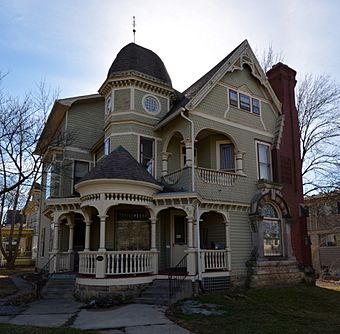Linsay House facts for kids
Quick facts for kids |
|
|
Lindsay House
|
|
 |
|
| Location | 935 E. College Iowa City, Iowa |
|---|---|
| Area | less than one acre |
| Built | 1893 |
| Architect | George F. Barber and Co. |
| Architectural style | Queen Anne |
| NRHP reference No. | 77000529 |
| Added to NRHP | August 2, 1977 |
The Lindsay House is a historic building located in Iowa City, Iowa, United States. It was added to the National Register of Historic Places in 1977. This means it is a special place recognized for its history and unique design.
History and Design of the Lindsay House
The Lindsay House was built in 1893. A man named John Jayne, who built bridges in Iowa City, had it constructed. He bought the plans for this large, two-and-a-half-story house from a company called George F. Barber and Co..
The house is built in the Queen Anne style. This style was popular for homes in the late 1800s. The Lindsay House has many interesting features. It has a large chimney that takes up an entire corner of the front of the house. There is also a stone arch around a first-floor window. This window has special leaded glass with a sunflower pattern. The house also has a porch that wraps around the side, with a small tower at the corner. Behind the main part of the house, there is an even taller, three-story tower with eight sides.
A Special Gift and a Famous Comic Strip
John Jayne built the Lindsay House as a wedding gift for his daughter, Ella. She married John Granger Lindsay, and they lived in the house. The Lindsays moved away to Chicago in 1913.
After they left, the house was divided into several apartments. In 2005, it became a large, 10-bedroom home for a group called the River City Housing Collective.
The Lindsay House is perhaps most famous for its connection to a popular comic strip called Bloom County. The house was used as the model for the boarding house in the comic strip. Parts of the comic strip's stories were also set there. Berkeley Breathed, who created Bloom County, once joked about the house. He called it one of "the ugliest houses in the five-state area." He also said its mix of six different architectural styles was a "landmark to bad taste." Even so, its unique look made it memorable enough to be featured in a famous comic!



